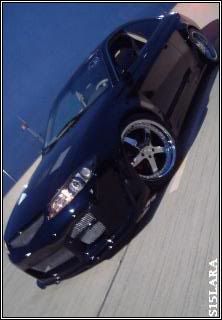wargoah wrote:.......
HID use high voltage with 35w arc bulb which means lower amp than factory halogen light bulb.
Correct. HID uses less wattage, 35w, but during each start-up it'll use up to 3 times the voltage:
Taken from faqlight.carpassion.info
Why can't I power HID systems from stock headlight wiring?
Lets start off and show how it really looks like under the hood:

Imagine that we connect the HID ballast directly to where the low beam halogen bulb is connected. Some vehicles might be are able to power up HID systems normally without problems at install time. Most probably, it will not last long. The inrush load can be up to max 13 amps per ballast, compared to 7amps inrush when using halogen. The factory design parameters for headlight curcuit is 7 amps inrush and 4.5 amps continous load. So over time, connectors, multifunction switch, headlight switch, wiring and fuse holders will slowly degrade, beacuse of heat buildup. These components are very time consuming to troubleshoot becuse they are usully well hidden behind dashboards and other wiring looms. Parts easily reaches several hundered dollars. Add 8h labour to that and it becomes obvious that a $50 wiring harness is a cheap insurance.
How can I ensure that I do not fry my cars internal headlight harness?
During normal HID operation, you use only 42 watts (35W to run the bulb plus 7W in heat losses in ballast) instead of the 55 watts that the halogen bulb uses, which is less, but, during HID cold startup, and for the first several seconds during warmup, the HID system can draw up to triple the normal operating power to run the ignitor circuit during that time. As the bulb warms up, the current draw tapers down to the normal running level. By powering the ballast through a relay straight from the battery to HID ballast, the heavy load is removed from stock headlight curcuit. Triggering the relay only requires 0.1 amps, so stock headlamp curcuit has no problem powering that. A relay is just a remotely mounted heavy duty switch, and the trigger power that goes to it just draws a small amount of current through the headlight switch to run an electromagnet that mechanically closes the contacts inside the relay which in turn hooks battery power strait to HID ballast power terminal. This insures that you wont ever overdrive the ratings of your vehicle's harness.
fin...
I understand most of the guys here run HIDS through stock and have had no problems with it. Trust me, I thought the same. I mean why do anythign to it if it sworking fine, right? I run all my HIDs through a relay.
But check the stock connectors and the connectors for the ballast after a few months, you MIGHT see some burnt marks which is a sign of the voltage overload as described above.
In any case, if you want to run it though your stock wiring, fine, its your call. Just wanted let you be aware of what could happen.
Bunthy







